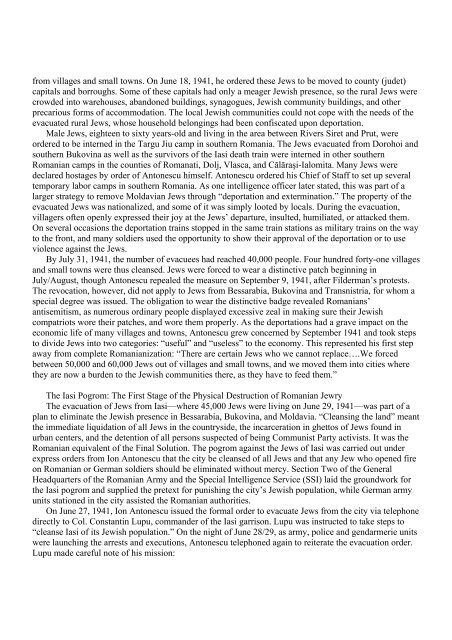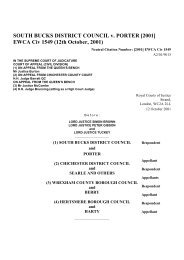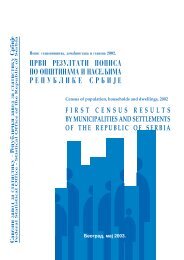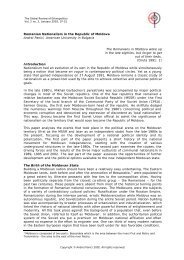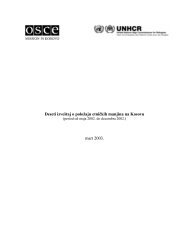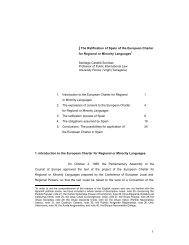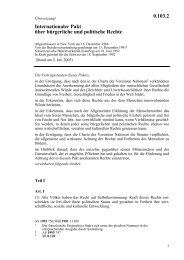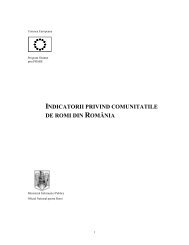Final Report of the International Commission on the - Minority Rights ...
Final Report of the International Commission on the - Minority Rights ...
Final Report of the International Commission on the - Minority Rights ...
You also want an ePaper? Increase the reach of your titles
YUMPU automatically turns print PDFs into web optimized ePapers that Google loves.
from villages and small towns. On June 18, 1941, he ordered <str<strong>on</strong>g>the</str<strong>on</strong>g>se Jews to be moved to county (judet)<br />
capitals and borroughs. Some <str<strong>on</strong>g>of</str<strong>on</strong>g> <str<strong>on</strong>g>the</str<strong>on</strong>g>se capitals had <strong>on</strong>ly a meager Jewish presence, so <str<strong>on</strong>g>the</str<strong>on</strong>g> rural Jews were<br />
crowded into warehouses, aband<strong>on</strong>ed buildings, synagogues, Jewish community buildings, and o<str<strong>on</strong>g>the</str<strong>on</strong>g>r<br />
precarious forms <str<strong>on</strong>g>of</str<strong>on</strong>g> accommodati<strong>on</strong>. The local Jewish communities could not cope with <str<strong>on</strong>g>the</str<strong>on</strong>g> needs <str<strong>on</strong>g>of</str<strong>on</strong>g> <str<strong>on</strong>g>the</str<strong>on</strong>g><br />
evacuated rural Jews, whose household bel<strong>on</strong>gings had been c<strong>on</strong>fiscated up<strong>on</strong> deportati<strong>on</strong>.<br />
Male Jews, eighteen to sixty years-old and living in <str<strong>on</strong>g>the</str<strong>on</strong>g> area between Rivers Siret and Prut, were<br />
ordered to be interned in <str<strong>on</strong>g>the</str<strong>on</strong>g> Targu Jiu camp in sou<str<strong>on</strong>g>the</str<strong>on</strong>g>rn Romania. The Jews evacuated from Dorohoi and<br />
sou<str<strong>on</strong>g>the</str<strong>on</strong>g>rn Bukovina as well as <str<strong>on</strong>g>the</str<strong>on</strong>g> survivors <str<strong>on</strong>g>of</str<strong>on</strong>g> <str<strong>on</strong>g>the</str<strong>on</strong>g> Iasi death train were interned in o<str<strong>on</strong>g>the</str<strong>on</strong>g>r sou<str<strong>on</strong>g>the</str<strong>on</strong>g>rn<br />
Romanian camps in <str<strong>on</strong>g>the</str<strong>on</strong>g> counties <str<strong>on</strong>g>of</str<strong>on</strong>g> Romanati, Dolj, Vlasca, and Călăraşi-Ialomita. Many Jews were<br />
declared hostages by order <str<strong>on</strong>g>of</str<strong>on</strong>g> Ant<strong>on</strong>escu himself. Ant<strong>on</strong>escu ordered his Chief <str<strong>on</strong>g>of</str<strong>on</strong>g> Staff to set up several<br />
temporary labor camps in sou<str<strong>on</strong>g>the</str<strong>on</strong>g>rn Romania. As <strong>on</strong>e intelligence <str<strong>on</strong>g>of</str<strong>on</strong>g>ficer later stated, this was part <str<strong>on</strong>g>of</str<strong>on</strong>g> a<br />
larger strategy to remove Moldavian Jews through “deportati<strong>on</strong> and exterminati<strong>on</strong>.” The property <str<strong>on</strong>g>of</str<strong>on</strong>g> <str<strong>on</strong>g>the</str<strong>on</strong>g><br />
evacuated Jews was nati<strong>on</strong>alized, and some <str<strong>on</strong>g>of</str<strong>on</strong>g> it was simply looted by locals. During <str<strong>on</strong>g>the</str<strong>on</strong>g> evacuati<strong>on</strong>,<br />
villagers <str<strong>on</strong>g>of</str<strong>on</strong>g>ten openly expressed <str<strong>on</strong>g>the</str<strong>on</strong>g>ir joy at <str<strong>on</strong>g>the</str<strong>on</strong>g> Jews’ departure, insulted, humiliated, or attacked <str<strong>on</strong>g>the</str<strong>on</strong>g>m.<br />
On several occasi<strong>on</strong>s <str<strong>on</strong>g>the</str<strong>on</strong>g> deportati<strong>on</strong> trains stopped in <str<strong>on</strong>g>the</str<strong>on</strong>g> same train stati<strong>on</strong>s as military trains <strong>on</strong> <str<strong>on</strong>g>the</str<strong>on</strong>g> way<br />
to <str<strong>on</strong>g>the</str<strong>on</strong>g> fr<strong>on</strong>t, and many soldiers used <str<strong>on</strong>g>the</str<strong>on</strong>g> opportunity to show <str<strong>on</strong>g>the</str<strong>on</strong>g>ir approval <str<strong>on</strong>g>of</str<strong>on</strong>g> <str<strong>on</strong>g>the</str<strong>on</strong>g> deportati<strong>on</strong> or to use<br />
violence against <str<strong>on</strong>g>the</str<strong>on</strong>g> Jews.<br />
By July 31, 1941, <str<strong>on</strong>g>the</str<strong>on</strong>g> number <str<strong>on</strong>g>of</str<strong>on</strong>g> evacuees had reached 40,000 people. Four hundred forty-<strong>on</strong>e villages<br />
and small towns were thus cleansed. Jews were forced to wear a distinctive patch beginning in<br />
July/August, though Ant<strong>on</strong>escu repealed <str<strong>on</strong>g>the</str<strong>on</strong>g> measure <strong>on</strong> September 9, 1941, after Filderman’s protests.<br />
The revocati<strong>on</strong>, however, did not apply to Jews from Bessarabia, Bukovina and Transnistria, for whom a<br />
special degree was issued. The obligati<strong>on</strong> to wear <str<strong>on</strong>g>the</str<strong>on</strong>g> distinctive badge revealed Romanians’<br />
antisemitism, as numerous ordinary people displayed excessive zeal in making sure <str<strong>on</strong>g>the</str<strong>on</strong>g>ir Jewish<br />
compatriots wore <str<strong>on</strong>g>the</str<strong>on</strong>g>ir patches, and wore <str<strong>on</strong>g>the</str<strong>on</strong>g>m properly. As <str<strong>on</strong>g>the</str<strong>on</strong>g> deportati<strong>on</strong>s had a grave impact <strong>on</strong> <str<strong>on</strong>g>the</str<strong>on</strong>g><br />
ec<strong>on</strong>omic life <str<strong>on</strong>g>of</str<strong>on</strong>g> many villages and towns, Ant<strong>on</strong>escu grew c<strong>on</strong>cerned by September 1941 and took steps<br />
to divide Jews into two categories: “useful” and “useless” to <str<strong>on</strong>g>the</str<strong>on</strong>g> ec<strong>on</strong>omy. This represented his first step<br />
away from complete Romanianizati<strong>on</strong>: “There are certain Jews who we cannot replace….We forced<br />
between 50,000 and 60,000 Jews out <str<strong>on</strong>g>of</str<strong>on</strong>g> villages and small towns, and we moved <str<strong>on</strong>g>the</str<strong>on</strong>g>m into cities where<br />
<str<strong>on</strong>g>the</str<strong>on</strong>g>y are now a burden to <str<strong>on</strong>g>the</str<strong>on</strong>g> Jewish communities <str<strong>on</strong>g>the</str<strong>on</strong>g>re, as <str<strong>on</strong>g>the</str<strong>on</strong>g>y have to feed <str<strong>on</strong>g>the</str<strong>on</strong>g>m.”<br />
The Iasi Pogrom: The First Stage <str<strong>on</strong>g>of</str<strong>on</strong>g> <str<strong>on</strong>g>the</str<strong>on</strong>g> Physical Destructi<strong>on</strong> <str<strong>on</strong>g>of</str<strong>on</strong>g> Romanian Jewry<br />
The evacuati<strong>on</strong> <str<strong>on</strong>g>of</str<strong>on</strong>g> Jews from Iasi—where 45,000 Jews were living <strong>on</strong> June 29, 1941—was part <str<strong>on</strong>g>of</str<strong>on</strong>g> a<br />
plan to eliminate <str<strong>on</strong>g>the</str<strong>on</strong>g> Jewish presence in Bessarabia, Bukovina, and Moldavia. “Cleansing <str<strong>on</strong>g>the</str<strong>on</strong>g> land” meant<br />
<str<strong>on</strong>g>the</str<strong>on</strong>g> immediate liquidati<strong>on</strong> <str<strong>on</strong>g>of</str<strong>on</strong>g> all Jews in <str<strong>on</strong>g>the</str<strong>on</strong>g> countryside, <str<strong>on</strong>g>the</str<strong>on</strong>g> incarcerati<strong>on</strong> in ghettos <str<strong>on</strong>g>of</str<strong>on</strong>g> Jews found in<br />
urban centers, and <str<strong>on</strong>g>the</str<strong>on</strong>g> detenti<strong>on</strong> <str<strong>on</strong>g>of</str<strong>on</strong>g> all pers<strong>on</strong>s suspected <str<strong>on</strong>g>of</str<strong>on</strong>g> being Communist Party activists. It was <str<strong>on</strong>g>the</str<strong>on</strong>g><br />
Romanian equivalent <str<strong>on</strong>g>of</str<strong>on</strong>g> <str<strong>on</strong>g>the</str<strong>on</strong>g> <str<strong>on</strong>g>Final</str<strong>on</strong>g> Soluti<strong>on</strong>. The pogrom against <str<strong>on</strong>g>the</str<strong>on</strong>g> Jews <str<strong>on</strong>g>of</str<strong>on</strong>g> Iasi was carried out under<br />
express orders from I<strong>on</strong> Ant<strong>on</strong>escu that <str<strong>on</strong>g>the</str<strong>on</strong>g> city be cleansed <str<strong>on</strong>g>of</str<strong>on</strong>g> all Jews and that any Jew who opened fire<br />
<strong>on</strong> Romanian or German soldiers should be eliminated without mercy. Secti<strong>on</strong> Two <str<strong>on</strong>g>of</str<strong>on</strong>g> <str<strong>on</strong>g>the</str<strong>on</strong>g> General<br />
Headquarters <str<strong>on</strong>g>of</str<strong>on</strong>g> <str<strong>on</strong>g>the</str<strong>on</strong>g> Romanian Army and <str<strong>on</strong>g>the</str<strong>on</strong>g> Special Intelligence Service (SSI) laid <str<strong>on</strong>g>the</str<strong>on</strong>g> groundwork for<br />
<str<strong>on</strong>g>the</str<strong>on</strong>g> Iasi pogrom and supplied <str<strong>on</strong>g>the</str<strong>on</strong>g> pretext for punishing <str<strong>on</strong>g>the</str<strong>on</strong>g> city’s Jewish populati<strong>on</strong>, while German army<br />
units stati<strong>on</strong>ed in <str<strong>on</strong>g>the</str<strong>on</strong>g> city assisted <str<strong>on</strong>g>the</str<strong>on</strong>g> Romanian authorities.<br />
On June 27, 1941, I<strong>on</strong> Ant<strong>on</strong>escu issued <str<strong>on</strong>g>the</str<strong>on</strong>g> formal order to evacuate Jews from <str<strong>on</strong>g>the</str<strong>on</strong>g> city via teleph<strong>on</strong>e<br />
directly to Col. C<strong>on</strong>stantin Lupu, commander <str<strong>on</strong>g>of</str<strong>on</strong>g> <str<strong>on</strong>g>the</str<strong>on</strong>g> Iasi garris<strong>on</strong>. Lupu was instructed to take steps to<br />
“cleanse Iasi <str<strong>on</strong>g>of</str<strong>on</strong>g> its Jewish populati<strong>on</strong>.” On <str<strong>on</strong>g>the</str<strong>on</strong>g> night <str<strong>on</strong>g>of</str<strong>on</strong>g> June 28/29, as army, police and gendarmerie units<br />
were launching <str<strong>on</strong>g>the</str<strong>on</strong>g> arrests and executi<strong>on</strong>s, Ant<strong>on</strong>escu teleph<strong>on</strong>ed again to reiterate <str<strong>on</strong>g>the</str<strong>on</strong>g> evacuati<strong>on</strong> order.<br />
Lupu made careful note <str<strong>on</strong>g>of</str<strong>on</strong>g> his missi<strong>on</strong>:


